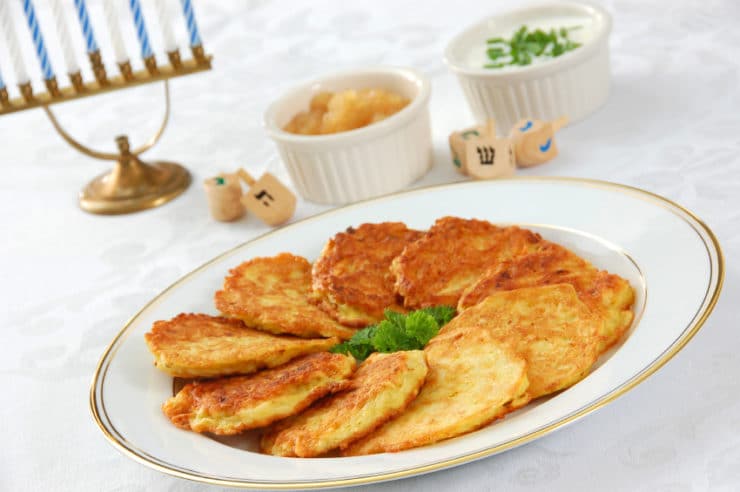
In an earlier blog, I wrote about the two major Jewish groups in the world– Ashkenazi Jews and Sephardic Jews. These two groups have the same religious beliefs, but their cooking styles are quite different. Ashkenazi foods might seem more familiar to American cooks (matzo ball soup and gefilte fish), while Sephardic foods tend to be more exotic in terms of flavor (shakshuka and hummus). Why the difference?
It basically boils down to the weather. Ashkenazi food is reflective of the colder regions where Ashkenazi Jews settled (Germany, Russia, Eastern Europe, etc.). To survive a Russian or Polish winter, one needed heavy, rib-sticking cuisine. Ashkenazi cooking includes lots of potatoes, bread, pastries, noodles, meat, honey, and pickled foods.
Sephardi Jews originally lived in Spain and Portugal. After being expelled in the 15th century, most of the Sephardi settled in warmer areas of the Mediterranean (Morocco, Turkey, Italy). Because of the sunny climate, they had easier access to fresh vegetables, fish, fruits, spices and olive oil. Therefore, Sephardic cuisine tends to be lighter, healthier, and more colorful.
Many traditional dishes can be found in both Ashkenazi and Sephardic traditions, with slight variations. Chamin is a Sephardic stew made for Shabbat. A very similar dish can be found in Ashkenazi tradition—it’s called Cholent. Both dishes evolved for the same reason (to avoid cooking during the hours of Shabbat), and have the same basic ingredients. However, they are spiced and prepared differently in each tradition, so that each stew has its own distinct flavor.
Most Jewish cooks today are influenced by both Ashkenazi and Sephardic cuisines. Both populations have taken advantage of the regional resources available to them, and have in turn created many exciting dishes. From Indian to Russian to Moroccan to Polish, Jewish food is extremely diverse. One thing all of these dishes have in common—they are unique and delicious!
Enough history for today. I’m off to cook an Ashkenazi-style brisket for a Shabbat dinner gathering tomorrow. I try to make brisket a day ahead of time… leaving it in the refrigerator overnight allows the flavors to marinate. In a future blog, I’ll share a few more secrets for cooking the perfect brisket.
What kind of Jewish cuisine are you most familiar with– Ashkenazi or Sephardic?



Thank you for whatever you send me! I’m practically a vegetarian so Mediterranean dishes, especially fruits and vegetables, will be exciting to me.
Thank you Tori! Your research is second to none! I went right to your Ashkenazi Brisket recipe! We had it last evening and I am still nibbling! YUMMY!
Are Yemenite Jews also a major influence in Jewish cuisine? I only ask because the name has come up a lot in my research… But I’m focusing at the moment more on Ashkenazi Jews because I’m looking for a good Russian-Israeli recipe. So far the only lead I have is borscht, and I can’t really find a recipe that I like anywhere… *hint hint*
Hi Kalia, here is more information on Yemenite Jewish cuisine: http://theshiksa.com/2010/12/29/yemenite-soup/
I don’t have a good borscht recipe on the site yet, but it’s definitely on my to-do list. 🙂
Sephardic food and cuisine all meshed together when the Mizrachi Jews came to Israel around 1948. I would bet there’s a lot of influence across all the groups in terms of food and cuisine. My husband is part Sephardic (Spanish) and part Egyptian/Turkish. The customs I follow are those customs- but I cook everything. What is interesting about the Yemenites, they keep their traditions very much intact despite having assimilated into other cultures. Good luck.
I was born Ashkenazi, but I married a Sephardic man and I have quickly adopted and brought the Sephradic cuisine, cooking style and spice collection into my kitchen. (and yes, passover is very easy now! ha!). I love, love, love to cook! and boy, do I cook everything. The rule in my house is – if you walk in the door, I feed you (or at least try hard to feed you). If you help us out around the house- I feed you.
I think you forgot to mention Mizrachi Jews- Middle Eastern, Northern African and Indian Jews. The food and even the customs are sometimes very different. Today since everyone has moved around so much, the term “Sephardic Jews” encompasses both groups.
I am sure you’re busy, but I would love to talk food with you!
Sephardic Cuisine but I love both <3
Hi there, I love your site. Did you know there are also Greek Jews: Romaniotes? The food is Greek kosher food, and is different than Sephardic. There is actually a Romaniote cookbook: THE COOKBOOK OF THE JEWS OF GREECE
Nicholas Stavroulakis
Lycabettus Press, Athens, 1986
Recipes and customs of Romaniote and Sephardic Jews of Greece; drawings.
If you haven’t seen it I think you might enjoy it.
G-d bless you on your journey ~ from a Shiksa in So. California
I’m a Shiksa who was married to a Lebanese so I’m probably already cooking some of that Sephardi Cuisine. Yummo!
Love it!
Those look like the latkes you made for Hannukah – taste as delicious as they look!